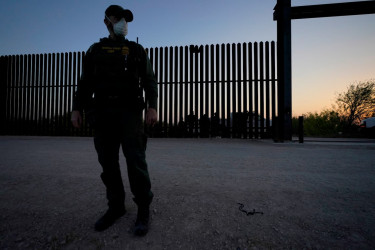In 1862, California physician Arthur B. Stout published a scathing report with a terrifying title: “Chinese Immigration and the Physiological Causes of the Decay of the Nation.” According to Stout, newcomers from China were spreading tuberculosis, syphilis and other diseases that could “insidiously poison the well-springs of life” and “corrode the vitals of our strength and prosperity” in the United States.
Sound familiar? That’s what Republican politicians have been saying in recent weeks about the coronavirus: It’s being brought here by immigrants. That’s not true, any more than it was about the Chinese and disease in the 19th century. But it speaks to an old theme in American history: When an epidemic arrives, we blame non-Americans.
That happened right after the coronavirus pandemic began, of course, when President Donald Trump called it the “China virus” or even “Kung Flu,” a racist trope that helped fuel a dangerous increase in anti-Asian violence.
And it’s happening again now, despite there being no evidence to suggest that Latin American immigrants are responsible for recent upticks in coronavirus infections, as Florida Gov. Ron DeSantis (R) and others have suggested, while deflecting criticisms about their policies banning masks or slowing vaccinations. Evidence suggests that recently arrived migrants have similar infection rates as the local population in places such as McAllen, Tex., and more importantly, nearly 100 percent of migrants released into the United States have tested negative, or have been offered or provided a place to quarantine if they test positive.
But Americans have always linked epidemics to those deemed outsiders, as Alan M. Kraut demonstrated in his indispensable 1994 book “Silent Travelers.” They provide a convenient scapegoat, absolving the rest of us from responsibility for the disease and death in our midst.
So when a smallpox epidemic seized San Francisco in 1876, the city health officer blamed it on “unscrupulous, lying, and treacherous Chinamen who have disregarded our sanitary laws.” Others charged that Chinese immigrants were spreading leprosy, one of the most fearsome diseases of all. To drum up support for restricting Chinese immigration, which would culminate in the federal 1882 Chinese Exclusion Act, White San Franciscans drove disfigured “Chinese lepers” around the city — although there was no evidence that these men actually had leprosy.
In 1900, when a Chinese immigrant in San Francisco was diagnosed with bubonic plague, officials cordoned off the 15-block Chinatown community with rope. Acknowledging the need to quarantine individuals who had been exposed to the illness, Chinese Americans condemned the barricading of their entire neighborhood. “Never have we heard of blocking the whole town,” a Chinese American newspaper declared.
In the early 20th century, as millions of immigrants from Southern and Eastern Europe entered American cities, they were accused of bringing diseases with them. “Steerage passengers from a Naples boat show a distressing frequency of low foreheads, open mouths, weak chins, poor features, skew faces, small or knobby crania, and backless heads,” observed sociologist E.A. Ross in 1914, drawing on the era’s eugenic language to denounce Italian immigrants. “Such people lack the power to take rational care of themselves.” Ross reported that Italians’ death rate from disease was twice the New York norm; in fact, data compiled by an insurance company showed that Italian mortality was lower than the citywide average.
Ditto for Jews, who were less likely to contract fatal illnesses than most other ethnic groups. But that did not prevent Ross from denouncing them as vectors for disease, thanks to their allegedly inherent frailties. “On the physical side the Hebrews are the polar opposite of our pioneer breed,” Ross wrote. “Not only are they undersized and weak muscled, but they shun bodily activity and are exceedingly sensitive to pain.” The point of these observations wasn’t to uphold public health, but to disparage entire ethnic communities that were seen as inferior.
AdvertisementStory continues below advertisement
To be sure, immigrants who crammed into urban tenements contracted tuberculosis and other ailments associated with dense living quarters and poor sanitation. That was a chief motivator for municipal water treatment, housing regulations and other reforms of the Progressive Era. But many native-born Americans continued to insist that the problem resided within immigrants’ bodies, not in the environments where they lived and worked.
That belief undergirded the Immigration Act of 1924, which established quotas favoring newcomers from Northern and Western Europe, limiting Southern and Eastern Europeans and excluding nearly all Asian people. But even after Congress removed those quotas in 1965, the link between immigrants and disease remained.
So when the HIV/AIDS crisis began in the early 1980s, the Centers for Disease Control and Prevention classified Haitian newcomers as a special high-risk category alongside gay men and intravenous drug users. But there was no real evidence that Haitians were more likely to carry the virus than anybody else. Indeed, a federal official later admitted, “Haitians were the only risk group that were identified because of who they were rather than what they did.”
AdvertisementStory continues below advertisement
Alas, they wouldn’t be the last one. In 2014, Rep. Phil Gingrey (R-Ga.) warned “illegal migrants” were “carrying deadly diseases such as swine flu, dengue fever, Ebola virus, and tuberculosis” across America’s border with Mexico. Pressed by a journalist to identify any specific Ebola carriers, Gingrey — a physician by training — admitted that he didn’t know any.
But he didn’t have to know, either. A few months later, amid a new global Ebola scare, Senate candidate Thom Tillis (R-N.C.) said the only proper response was to “seal the border and secure it.” He also charged that there were “bad actors coming across the border,” but — like Gingrey — he didn’t actually identify them. Others called for banning all migrants from West Africa, whether Ebola had appeared in their countries.
They say that history repeats itself, first as a tragedy and then as a farce. The coronavirus is spreading most rapidly in places with low vaccination rates, not high immigration. We could contain it by inoculating more Americans and by taking other simple precautions such as wearing masks. But in the states with the most disease and death, politicians are pointing fingers at people south of the border instead of working to change behaviors.
We have met the enemy, and it is us. But it’s always easier to blame an outsider than it is to look in the mirror, or into our own broken hearts.
Today's HeadlinesThe most important news stories of the day, curated by Post editors and delivered every morning.











